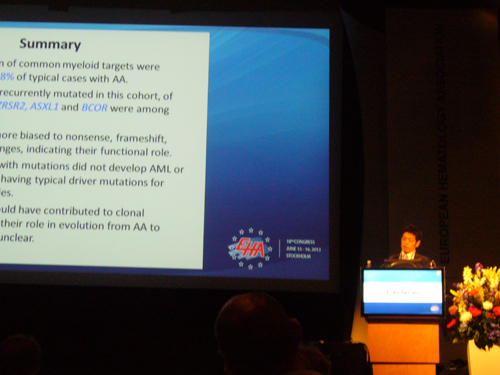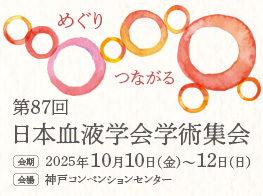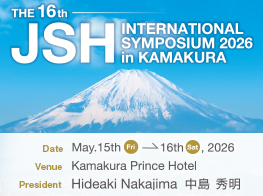
名前:吉里 哲一【東京大学医学部附属病院 がんゲノミクスプロジェクト】
発表日時:2013年6月16日
発表形式:Oral
Title:
SPECTRUM OF GENETIC ALTERATIONS IN ACQUIRED APLASTIC ANEMIA
Authors:
Tetsuichi Yoshizato 1, Kohei Hosokawa 2, Kenichi Yoshida 1, Yusuke Okuno 3, Kenichi Chiba 4, Hiroko Tanaka 5, Yuichi Shiraishi 4, Yasunobu Nagata 1, Takamasa Katagiri 2, Ayana Kon 1, Masashi Sanada 1, Satoru Miyano 4, 5, Shinji Nakao 2, Seishi Ogawa 1
Affiliations:
1Cancer Genomics Project, The University of Tokyo, Tokyo, 2Cellular Transplantation Biology, Division of Cancer Medicine, Graduate School of Medical Science, Kanazawa University, Kanazawa, 3Depertment of Pediatrics, Graduate School of Medecine, Nagoya University, Nagoya, 4Laboratory of DNA information Analysis, Human Genome Center, 5Laboratory of Sequence Analysis, Human Genome Center, The University of Tokyo, Tokyo, Japan,
Abstract:
Background
Acquired aplastic anemia (AA) is a prototype of idiopathic bone marrow failure, which is caused by autoimmune destruction of hematopoietic progenitors. However, its natural course could be more complicated than expected for a simple autoimmune disease, which is related in large part to the development of apparently clonal disorders such as paroxysmal nocturnal hemoglobinuria (PNH) and myelodysplastic syndrome (MDS) or acute myelogenous leukemia (AML), during its course. In addition, clonality in AA is one of the long standing issues, which is evident from the cytogenetic abnormalities and skewed pattern of X chromosome inactivation in some patients. Although these evidences suggest a pathogeneic link between these disorders, clonal architecture in AA has not been fully explored.
Aims
To genetically define the origin of clonal hematopoiesis in patients with acquired AA in terms of gene mutations.
Methods
We analyzed peripheral blood DNA samples from 192 patients with AA for genetic alterations, in which coding sequences of 51 genes, which include common target of somatic mutations in myeloid malignancies, such as RUNX1, ASXL1, TET2, IDH1/2, DNMT3A and major components of splicing factors, were captured by liquid phase hybridization and subjected to high-throughput sequencing using Illumina HiSeq 2000. Copy number alterations have been also examined using SNP arrays analysis in all cases.
Results
About 40% were severe or very severe diseases. PNH-type cells and uniparental disomy at short arm of 6th chromosome (6pUPD) were found in 55% and 12%, respectively. Immunosuppressive therapies were performed in 70% of the cases. 32% of the cases had ATG. Response was obtained in 81% of the informative cases. 169 single nucleotide variants (SNV) are detected by target sequencing, which were subjected to deep sequencing. Finally 43 somatic mutations were detected in 34 patients (18%). Mutations were most frequently found in DNMT3A (7 mutations), followed by ZRSR2 (6), ASXL1 (5), BCOR (4), however TET2 mutations, which are most commonly observed in MDS, were not identified. Mutations were more biased to nonsense (11 mutations), frameshift (6), splice site changes (3) and non-frameshift indel (5), compared to missense (18). There was no significant difference in severity, positive PHN-type cells, 6pUPD, or copy number abnormalities between mutation positive and negative cases. Mutations were associated with older age (p=0.014) and higher response to immunosuppressive therapies (p=0.040). SNP array analysis revealed copy number abnormalities in 24/192 cases (12.5%), in whom 6pUPD were observed most commonly (6.3%), therefore 51/192 cases (26.6%) had evidence of clonal evolution. In most cases with more than 5 years observation periods, no progression to AML or MDS has been reported.
Summary / Conclusion
Although the role of observed mutations in evolution from AA to AML/MDS is still unclear, we revealed a new insight of clonality in AA. In the meeting, we will introduce our findings including clinical course in some typical AA cases with mutations.
EHA参加報告書
今回、EHA Travel Awardを受賞し、6月13日から16日にスウェーデンの首都ストックホルムで開催されたThe 17th EHA congressに参加し、発表する機会をいただきました。学会は、Stockholmsmassanというストックホルム中心部から郊外電車に乗って15分程の距離にある国際展示場で行われました。
ストックホルムは北緯59°と高緯度にあるため、白夜までとはいきませんが、日の入りが23時頃、日の出が3時頃と日照時間が長く、学会が終わった後も明るく、有意義な時間を過ごすことができました。市街地は14の島にまたがり、また旧市街地には古い建造物が保存された美しい町並みが広がっており、いくら散策しても飽きのこない町でした。
1日目は、企業主催のシンポジウムが開催され、2日目には多くの教育講演が組まれており、基礎・臨床の最新の知見に触れることができました。
3日目・4日目にSimultaneous Session・Plenary Session・Presidential Sessionなどが開催されました。また、3日目にはEHA Travel Award受賞された他の先生方、推薦者・JSH leadershipの先生方と昼食をともにする機会をセッティングしていただきました。食事はトナカイ肉の煮込みをメインとしたコース料理でした。現在医師となって9年目となりますが、血液内科を専攻した時期は遅いこともあり、普段他施設の血液内科の先生方と交流する機会があまりなく、大いに刺激を受けました。
4日目に「MDS Biology」のセッションで後天性再生不良性貧血における遺伝子変異に関して発表させていただきました。昨年度の日本血液学会で発表させていただいたのと、ほぼ同じ内容でしたが、初めての国際学会での発表であり、非常に緊張しました。セッション終了後には、再生不良性貧血の第一人者であるNational Heart, Lung and Blood InstituteのNeal Young博士ともお話をする機会にも恵まれました。Neal Young博士は、15日のplenary sessionで「Telomeres, genetics and hematologic diseases: potential impact on clinical course and treatment」と題した講演で、再生不良性貧血におけるclonal evolutionなど今回発表させていただいた内容とも関連した発表をされており、大変勉強になりました。
今回発表させていただいた研究により、再生不良性貧血においても、MDSで認めるような典型的な遺伝子変異を認めることが明らかになりましたが、同定された変異の意義は現時点では不明です。今後、再生不良性貧血診断時・寛解期・MDS/AMLへの進展時といった継時的検体を用いて、変異クローンの推移を評価し、再生不良性貧血の病態に迫りたいと考えています。
英語でのコミュニケーション・プレゼンテーション能力の未熟さを今回改めて、実感しました。今回の発表は無難に終了いたしましたが、質疑応答では、あまり込み入った質問がなく、より明快かつ魅力的にプレゼンできていれば、質疑応答も、もう少し盛り上がったものになったのかもしません。今後、研究を続けていく上でも、臨床を続けていく上でも、このような能力は不可欠と思いますので、精進していきたいと思います。
EHAは臨床・基礎関連の話題にバランスよく接することができ、また毎年ヨーロッパの様々な国で開催される面でも、大変魅力的な学会です。今後毎年発表できるように邁進していきたいと思います。
このような貴重な機会を設けていただいた日本血液学会の関係者にこの場を借りてお礼申し上げます。




